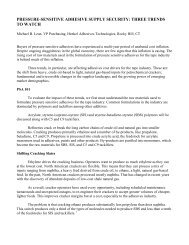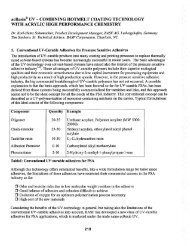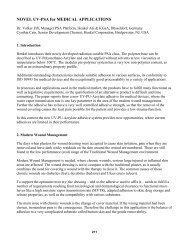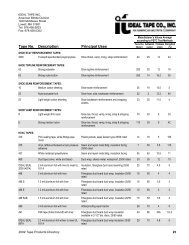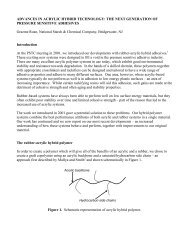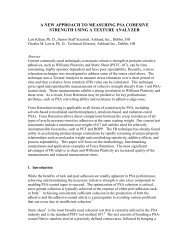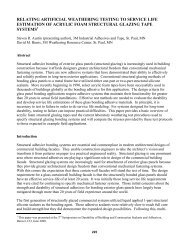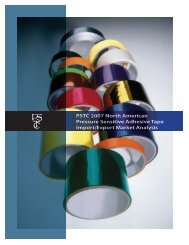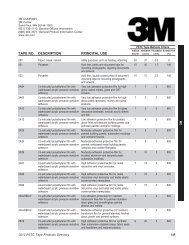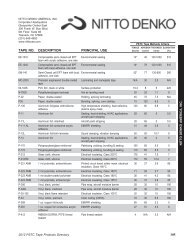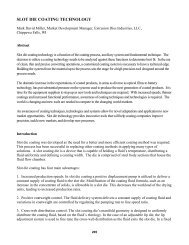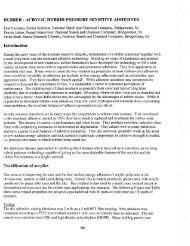sis / sbs based hmpsa for opp packaging tapes - PSTC. Pressure ...
sis / sbs based hmpsa for opp packaging tapes - PSTC. Pressure ...
sis / sbs based hmpsa for opp packaging tapes - PSTC. Pressure ...
Create successful ePaper yourself
Turn your PDF publications into a flip-book with our unique Google optimized e-Paper software.
SIS / SBS BASED HMPSA FOR OPP PACKAGING TAPES<br />
Lutz JACOB, Converting Application Manager, ExxonMobil Chemical Europe, Belgium<br />
Introduction<br />
Packaging tape is probably the largest volume application <strong>for</strong> pressure sensitive adhesives.<br />
Bioriented polypropylene (BOPP) film is the backing of choice with a share of about 70% in<br />
Europe and more than 90% in US and Asia.<br />
Of the different adhesives used with BOPP films, block copolymer <strong>based</strong> hot melt adhesives<br />
(HMPSA) are most popular in US while having a share of about 30% in Europe with fast<br />
growing tendency. These HMPSAs are generally <strong>based</strong> on styrene - isoprene block copolymers<br />
(SIS) because of their superior per<strong>for</strong>mance over time. One draw back is that, they are relatively<br />
expensive when compared to adhesives <strong>based</strong> on other block copolymers such as styrene-<br />
butadiene block copolymers (SBS).<br />
Another draw back is the sometimes limited availability of SIS block copolymers as it happened<br />
a few years ago.<br />
We have tried to develop SBS <strong>based</strong> HMPSA compositions over several years, without success.<br />
While the initial adhesive properties were acceptable, the aged properties declined rapidly when<br />
compared to SIS <strong>based</strong> PSA' s. Furthermore, the required adhesion to cardboard, particularly<br />
recycled cardboard was not sufficiently achieved.<br />
We then developed a SIS/SBS <strong>based</strong> HMPSA introducing a newly developed SBS, tailored to<br />
achieve the desired properties <strong>for</strong> an OPP <strong>packaging</strong> tape. The adhesive composition also uses 2<br />
different tackifiers, one compatible with SIS and one compatible with SBS.<br />
It is apparent that, using SBS as a key <strong>for</strong>mulation ingredient, will reduce the PSA cost<br />
considerably.<br />
It is within this respect that we would like to discuss the SIS/SBS HMPSA development in more<br />
detail<br />
Raw materials <strong>for</strong> <strong>for</strong>mulation development<br />
Table 1 summarizes the key properties of the SBS (DPX 579) developed <strong>for</strong> the discussed<br />
SIS/SBS adhesive system. The target was to develop a block copolymer, which is softer than<br />
typically used SBS types having a styrene content of about 30%. We wanted to achieve a<br />
composition, which provides in a 1:1 blend with a pure triblock SIS (Vector 4511) the ba<strong>sis</strong> <strong>for</strong> a<br />
high per<strong>for</strong>mance HMPSA <strong>for</strong> OPP <strong>tapes</strong>, comparable to SIS <strong>based</strong> HMPSA.<br />
We tried obviously to optimize the styrene content as well as the styrene block molecular weight<br />
in this respect. It has been found that the adhesive system reacts very sensitive to changes in<br />
styrene content i.e. shear drops significantly at too low styrene levels, vice versa, the tack and<br />
wetting behaviour deteriorated at higher styrene levels.<br />
235<br />
•<br />
I<br />
. . . . .<br />
• .<br />
•<br />
.,
I<br />
• ?<br />
As one can see from present table, we ended up with a styrene content of 25%, which provided<br />
the best compromise in terms of shear and wetting on cardboard. It is worth highlighting that this<br />
SBS is a pure triblock block copolymer, which has advantages over diblock containing products<br />
as we will discuss later in this paper.<br />
Obviously the tackifier resins used in such an adhesive composition play an important role too as<br />
far as well balanced PSA properties are concerned. The principle <strong>for</strong> the selection of the tackifier<br />
resins was to use a SIS compatible resin and a SBS compatible resin. As known by skilled<br />
people, SBS compatible hydrocarbon tackifiers need a relatively high aromatic content which has<br />
a detrimental effect on the shear of block copolymer <strong>based</strong> PSAs.<br />
Table 2 lists the properties of the tackifier resins, which were used <strong>for</strong> the development of the<br />
SIS/SBS HMPSA. As SIS tackifier a low aromatic modified C5 resin as widely used as single<br />
tackifier <strong>for</strong> SIS <strong>based</strong> adhesives was chosen (Escorez(R) 2211). The SBS tackifier is a medium<br />
aromatic modified C5 resin generally used as single SBS tackifier (ECR 373).<br />
HMPSA blend preparation and coating<br />
We use in our labs 2 types of z-blade mixers as well as 2 types of coating equipment.<br />
For screening work we use small 250 ml mixers which are electrically heated. Coating is carried<br />
out onto PET film on a 100 mm wide Acumeter HM coater. This system is easy to use and<br />
requires only small quantities of raw material.<br />
In an advanced step we use a 4 kg z-blade mixer which is equipped with a discharge screw. This<br />
discharge screw is at the same time a very efficient mixing tool by pushing the PSA compound<br />
continuously towards the mixing blades during the blending step. Coating of the HMPSA is<br />
conducted on a 300 mm wide Nordson HM coater equipped with a die with rotating bar. In this<br />
case OPP is being used as backing to make genuine OPP <strong>packaging</strong> <strong>tapes</strong>.<br />
Table 3 shows the blending procedures used with the different mixers.<br />
With both mixers we obtained perfectly homogeneous HMPSA blends in any SIS/SBS ratio.<br />
Figure 1 displays pictures of our mixing and coating devices.<br />
,Continuous Twin Screw Extruder Mixing<br />
In order to simulate typical state of the art mixing technology, we ran numerous experiments at<br />
Maris in Italy, one of the major twin screw compounding extruder manufacturers in Europe.<br />
For the trials a 30 mm extruder with a length of 54d has been used. SIS and SBS has been fed<br />
simultaneously into the first port, the resins were fed into port 3 and 4 and the oil at the end.<br />
Feeding was realized by means of gravimetric weighing systems.<br />
For the resin addition the extruder was equipped with cooled side feeding to avoid heat transfer to<br />
the resin h<strong>opp</strong>er. This is state of the art also <strong>for</strong> commercial Maris extruders.<br />
The oil was fed with a positive displacement gear pump.<br />
236
Figure 2 shows the torque development during mixing relative to the percentage of SBS used in<br />
the <strong>for</strong>mulation.<br />
From the data it is obvious that there is very little increase in torque with increasing the SBS ratio<br />
in the blend. This finding is contrary to rumors frequently spread in the industry that SBS<br />
crosslinks during compounding and eventually blocks the extruder.<br />
We can also see that, even without oil in the <strong>for</strong>mulation, the torque does not change relative to<br />
the <strong>for</strong>mulation with 10 phr oil.<br />
The temperature profile of the extruder can be seen in figure 3. At each feeding point of block<br />
copolymer and resin the temperature has been set at room temperature to avoid melting of<br />
products at the product inlet. If the <strong>for</strong>mulation contains 2 resins in different amounts, the resin<br />
with the smaller quantity should be fed first. This is advised to maintain the torque at a high<br />
enough level <strong>for</strong> a good blending.<br />
The temperature of the HMPSA at the extruder outlet is about 25 °C above the second half<br />
extruder temperature.<br />
The HMPSA was poured into siliconized boxes to cool down and be prepared <strong>for</strong> shipment to our<br />
labs <strong>for</strong> coating onto OPP film.<br />
SBS Stability during HM Processing<br />
During both, the z-blade mixing as well as the extruder mixing, no gel <strong>for</strong>mation of the SBS<br />
occurred. The gel <strong>for</strong>mation in SBS block copolymers during HM processing is a major concern<br />
people in the industry generally have.<br />
We believe that the process to make Vector pure triblock SBS provides a very stable product,<br />
particularly as far as heat and shear stability is concerned.<br />
Also after heating the HMPSA up again to a temperature of 175 °C <strong>for</strong> coating, no gel <strong>for</strong>mation<br />
took place. This additional heat history does not happen in continuous industrial operations,<br />
which means that, the danger of gel <strong>for</strong>mation there is even less.<br />
Based on our findings, the fear of getting gel <strong>for</strong>mation or even worth, extruder blocking during<br />
mixing, is baseless at least when using Vector (R) pure triblock SBS.<br />
Statistical experimental <strong>for</strong>mulation design<br />
A full factorial design with 4 variables has been per<strong>for</strong>med. 18 <strong>for</strong>mulations were prepared in 250<br />
ml z-blade mixers and consequently coated onto 36 micron PET film <strong>for</strong> testing. The coating was<br />
done from HM on a Acumeter lab coating machine.<br />
Variables <strong>for</strong> the design were SBS, SIS, SBS tackifier and SIS tackifier. The oil content was kept<br />
constant at 10 parts <strong>for</strong> all <strong>for</strong>mulations.<br />
Table 4 shows the numerical part of the statistics, listing basically all <strong>for</strong>mulations which have<br />
been per<strong>for</strong>med to run the design. This table is only added <strong>for</strong> completeness and will not be<br />
further discussed in the context of this paper.<br />
237<br />
.k<br />
k :- •
k<br />
,1<br />
?<br />
k<br />
In Table 5 the PSA properties are listed which have been tested to assess the per<strong>for</strong>mance of the<br />
PSA blends. All tests are <strong>based</strong> on AFERA, <strong>PSTC</strong> or FINAT Test Methods. The 2 most<br />
important properties concerning OPP <strong>packaging</strong> tape per<strong>for</strong>mance, are tack and shear on<br />
cardboard at 40 °C. The peel adhesion measured on steel gives only very little indication about<br />
the adhesion to cardboard since this is depending more on wetting and cohesion which in turn<br />
influences the shear properties.<br />
Another important attribute of a HMPSA <strong>for</strong> OPP <strong>packaging</strong> <strong>tapes</strong> is the melt viscosity.<br />
Typically HM OPP tape coating lines mn at high speed, actually up to 600 m/min or 1950 ft/min.<br />
This high speed requires a HMPSA with a relatively low melt viscosity at coating temperature to<br />
obtain a smooth, line free coating surface.<br />
For state of the art HM coaters equipped with a coating die with an integrated rotating bar, the<br />
viscosity should preferably be below 100 Pa.s.<br />
Discussion of Statistical Design Results<br />
In the course of this paper I will limit the discussion to the most important OPP Packaging Tape<br />
attributes namely, Loop Tack, Ball Tack and Shear on Cardboard at 40 °C. Melt viscosity at 175<br />
°C, due to its importance <strong>for</strong> the coating process, will be discussed as well.<br />
The first set of data (Figures 4 - 7) is <strong>based</strong> on 100 parts of rubber containing 50 parts of each,<br />
SBS and SIS. In this case the listed numbers on the contour graphs can be considered as resin<br />
phr, which makes the understanding easier.<br />
The Loop Tack is a measurement providing a good idea about wetting and adhesion of a PSA on<br />
any surface on which it is used. For the present study we per<strong>for</strong>med it on a standard stainless<br />
steel surface on which one can expect reliable and easily repeatable values. In Figure 4 we can<br />
see the dependence of the loop tack from the total resin content and more specifically from the<br />
SBS tackifier (ECR 373) content. This is due to the sensitivity of the SBS on the type of tackifier<br />
being used. There is no real minimum or maximum target <strong>for</strong> the loop tack since it depends<br />
vastly on the peel adhesion.<br />
The Ball Tack, Figure 5, on the other hand, seems to depend mainly on the amount of Escorez<br />
2211, the fraction of ECR 373 having a minor influence. This is not really in contrast to the loop<br />
tack findings, which we have discussed be<strong>for</strong>e since the Ball tack improves in the direction of<br />
reducing the Escorez 2211 fraction, which in turn me;ins, increasing the ECR 373 influence.<br />
When comparing the visual aspect of the Loop Tack and Ball Tack design, Figure 6, the shape of<br />
the contour lines looks completely different. A closer look teaches us that, in both cases we find<br />
the best per<strong>for</strong>mance at low SIS tackifier content and high SBS tackifier content in the<br />
<strong>for</strong>mulation.<br />
Un<strong>for</strong>tunately, designing PSA <strong>for</strong>mulations is not a straight <strong>for</strong>ward task, the incompatibility<br />
between tack and shear per<strong>for</strong>mance is well known in the art.<br />
As one could expect, we found this controversial behaviour back in this design study (Figure 7).<br />
The lower the resin content the better the shear with the higher impact coming from ECR 373.<br />
238
This is in perfect contradiction to what we found <strong>for</strong> the ball tack and loop tack design. The more<br />
negative impact of ECR 373 stems from its higher aromatic content which is needed <strong>for</strong> good<br />
SBS compatibility but simultaneously softens the styrene domains and thus reduces the shear.<br />
Comparing the HMPSA blend viscosity with the shear on cardboard at 40 °C, one finds an<br />
amazing similarity. The 2 designs look like mirror images. Normally we expect this similarity<br />
between the shear adhesion failure temperature (SAFT) and the melt viscosity but not with the 40<br />
°C shear on cardboard. One would certainly expect the same trend <strong>for</strong> those two features but not<br />
this detailed similarity. Notwithstanding these results, the contradiction here is that, we look <strong>for</strong><br />
high shear and low melt viscosity.<br />
The second set of design data (Figures 8 and 9) is <strong>based</strong> on a fixed resin ratio showing the 2<br />
block copolymers as variables. For this purpose we fixed the resins at 80 parts Escorez 2211 and<br />
30 parts ECR 373. This ratio has been chosen <strong>based</strong> on design results and the desire to minimize<br />
the SBS tackifier <strong>for</strong> its obvious detrimental impact on shear.<br />
!<br />
Since it is well known that, it is very difficult to obtain well balanced PSA properties with SBS,<br />
there is no surprise to find Loop Tack values which depend mostly on the amount of SIS in the<br />
<strong>for</strong>mulation, showing a maximum at a minimum SBS share (Figure 8). For the Ball tack we find<br />
a very similar design with the same conclusion as <strong>for</strong> the Loop Tack<br />
Figure 9 shows the comparison of shear on cardboard and melt viscosity. The design confirms<br />
what we found in the resin variable design already that, the highest shear is being obtained at the<br />
highest block copolymer ratio or in other words, at the lowest resin content. At the same time the<br />
design shows also that, the major impact <strong>for</strong> the shear stems from the SIS. This was to expect<br />
since SIS will always allow <strong>for</strong>mulation of superior PSA per<strong>for</strong>mance over SBS <strong>based</strong> systems as<br />
far <strong>tapes</strong> are concerned.<br />
The melt viscosity follows pretty much the pattern of the shear again. The key difference is that<br />
there is no particular impact of one or the other block copolymer.<br />
The software allows to calculate the optimal HMPSA blend composition <strong>based</strong> on desirability of<br />
one or the other PSA property. The example in Figure 10 is <strong>based</strong> on a maximum shear at 40 °C<br />
'desirability within the given max and min boundaries <strong>for</strong> each <strong>for</strong>mulation ingredient. We can<br />
see the much steeper lines <strong>for</strong> both block copolymers than <strong>for</strong> the resin, meaning that the impact<br />
of the rubbers on shear is much more pronounced than the one of the resins. The best <strong>for</strong>mulation<br />
composition in this case is given at the bottom of the graphs.<br />
DMA Analy<strong>sis</strong> of Selected Formulations<br />
DMA, this is well known, is an excellent tool to better understand and also to predict<br />
rubber/resin/plasticiser interactions of a pressure sensitive adhesive. There is one weakness,<br />
however, DMA cannot predict the adhesion of a PSA to difficult surfaces. It can only provide a<br />
number of supporting data on the intrinsic PSA properties but not on surface phenomena as<br />
present between a PSA and a contact surface.<br />
239<br />
/
-i ~ /~<br />
.<br />
°<br />
Following <strong>for</strong>mulations were selected:<br />
Vector 4511/DPX 579/Escorez 2211/ECR 373/Oil/AO<br />
Blend 1: 50/50/80/30/10/1<br />
Blend 2:50/50/73/27/5/1<br />
Blend 3: 50/50/80/30/5/1<br />
Vector 4511/Escorez 2203/Oil/AO<br />
Blend 4:100/110/10/1<br />
The DMA graph (Figure 11) shows the comparison of a standard SIS <strong>based</strong> HMPSA, as it is<br />
currently widely used in the industry, with 3 SIS/SBS <strong>based</strong> <strong>for</strong>mulations. Comparing Blend 1<br />
and 4, two <strong>for</strong>mulations with the same rubber/resin/oil ratio, it is noticeable that the plateau of the<br />
storage modulus is at the same level. The plateau of the SIS/SBS <strong>based</strong> PSA is a little shorter<br />
than the SIS one but in the most frequently used temperature range <strong>for</strong> <strong>packaging</strong> <strong>tapes</strong> (ca 20 -<br />
60 °C), there is very little difference. The T g in both cases is at- 5 °C, ensuring good tack at low<br />
temperatures.<br />
Blends 2 and 3, both SIS/SBS <strong>based</strong>, contain less resin and oil than Blends 1 and 4, resulting in a<br />
higher plateau modulus over the entire temperature range. This increase in modulus should result<br />
in poorer wetting properties, which we can only partially see when measuring PSA properties.<br />
The Ball tack value in both cases is slightly higher but at the same time the shear on cardboard at<br />
40 °C is higher too. The higher shear suggests that, the wetting is sufficiently good. It is 'needless<br />
to say that the shear on cardboard at room temperature is <strong>for</strong> all discussed <strong>for</strong>mulations beyond<br />
6000 minutes. The drawback of the lower resin and oil content is the higher cost, which may<br />
make this composition less attractive.<br />
Based on the PSA properties as well as the findings of the DMA analy<strong>sis</strong> we have chosen Blend<br />
1 <strong>for</strong> conducting a commercial tape plant trial.<br />
SIS/SBS HMPSA Per<strong>for</strong>mance<br />
While all the experimental design results are derived from HM coating onto PET film, we tested<br />
selected <strong>for</strong>mulations, coated onto OPP film.<br />
There is a distinctive difference in PSA properties between PET film coated material and OPP<br />
coated material. This difference is especially pronounced in the case of shear measurements on<br />
cardboard, at room temperature or elev.ated temperature, an attribute which is key <strong>for</strong> <strong>packaging</strong><br />
tape per<strong>for</strong>mance. The main reason <strong>for</strong> this difference is <strong>based</strong> on the film stability. In most cases<br />
a shear failure on cardboard begins with the tape lifting slightly at one edge and starting from this<br />
point the tape shears off in a given time. OPP film <strong>based</strong> <strong>tapes</strong> develop wrinkles over the contact<br />
area with the cardboard once one edge start to lift. Those wrinkles reduce the contact area which<br />
makes the shear failing faster. In case of PET film, because of the inherent film stability, those<br />
wrinkles do not occur and there<strong>for</strong>e the contact area of the tape with the cardboard remains stable<br />
<strong>for</strong> a longer time.<br />
240
Figure 12 displays the per<strong>for</strong>mance of OPP <strong>tapes</strong> made with our pilot operations. As mentioned<br />
earlier in the paper, the HMPSA blend has been made in a 4 liter z-blade mixer with discharge<br />
screw. The coating onto 28 micron OPP film was conducted on a 300 mm wide Nordson coater<br />
using a slot die with rotating bar.<br />
Two <strong>for</strong>mulations with the best balanced properties were selected from the experimental design.<br />
Formulation 1 is <strong>based</strong> on a 50/50 blend of SIS and SBS while <strong>for</strong>mulation 2 uses a higher share<br />
of SBS, which requires also a higher share of SBS tackifier.<br />
As far as the PSA properties are concerned, both <strong>for</strong>mulations show very similar per<strong>for</strong>mance,<br />
the peel adhesion and loop tack being lower <strong>for</strong> <strong>for</strong>mulation 2 with the higher SBS share.<br />
Surprisingly the shear on cardboard at 40 °C happens to be practically the same in both cases.<br />
Remarkable is the big difference in shear to the PET film <strong>based</strong> tape samples, we find similar<br />
differences also <strong>for</strong> pure SIS <strong>based</strong> <strong>tapes</strong>.<br />
As expected, the standard SIS <strong>based</strong> HMPSA shows higher peel and loop tack, both are not really<br />
important <strong>for</strong> box closure per<strong>for</strong>mance. Ball Tack is slightly better <strong>for</strong> the SIS <strong>based</strong> <strong>for</strong>mulation,<br />
but shear on cardboard in this case is lower which is surprising. The melt viscosity <strong>for</strong> all blends<br />
is low enough to allow high speed coating.<br />
The melt viscosity is the same in both cases, it is at a com<strong>for</strong>tably low level <strong>for</strong> high speed<br />
coating. When comparing the melt viscosity with the values of the experimental design, it can be<br />
noticed that the present values are lower than the design ones. The key reason <strong>for</strong> that is the<br />
stronger block copolymer degradation in the big mixer due to the high shear generated by the<br />
discharge screw. This has of course also a negative impact on the shear per<strong>for</strong>mance.<br />
Commercial Plant Coating Trial (Figure 13)<br />
In order to prove the commercial scale validity of the SIS/SBS concept, a coating trial has been<br />
conducted on a large HMPSA tape production line.<br />
Operation<br />
• State of the art HMPSA coating line, > 1.6 meter wide, max. speed > 500 m/min<br />
( 1520 ft/min)<br />
• Integrated Maris twin screw extruder with continuous gravimetric feeding<br />
• Inline release coating<br />
Extruder Mixin~<br />
• SIS and SBS feeding in first port<br />
• Temperatures" 30 - 190 °C<br />
• HMPSA temperature at outlet: 175 °C<br />
241<br />
k
Coating<br />
Q Slot die with rotating bar<br />
Coating Temperature: 175 °C<br />
Coating onto OPP film, 25 micron<br />
Coating weight: 18g/m 2<br />
Coating Speed: 200 m/min (610 ft/min)<br />
The tape per<strong>for</strong>mance is shown in Figure 14 in comparison with a typical commercial SIS <strong>based</strong><br />
OPP tape. As expected, the shear per<strong>for</strong>mance of the SIS/SBS <strong>based</strong> tape is somewhat lower<br />
when compared to the pure SIS <strong>based</strong> OPP tape. On the other hand it needs to be said that, the<br />
421 minutes shear value is in a range we frequently find on the market. A box closure test on<br />
highly recycled cardboard at 40 °C confirmed the good per<strong>for</strong>mance of the tape as far as practical<br />
use is concerned.<br />
Summary and Conclusion<br />
A SIS/SBS system <strong>based</strong> HMPSA <strong>for</strong> the coating of OPP <strong>tapes</strong> has been developed providing a<br />
high per<strong>for</strong>mance <strong>packaging</strong> tape. We have shown that the use of a tailored, pure triblock SBS in<br />
combination with SIS is a valid option to reduce cost and become less dependent on limited SIS<br />
supply.<br />
The general suspicion that SBS in HMPSA systems develops gels or even blocks extruders could<br />
be dispelled <strong>based</strong> on extruder mixing experiments as well as plant production tests.<br />
Work is under way at ExxonMobil Chemical to reduce the number of <strong>for</strong>mulation ingredients<br />
without adversely affecting the tape per<strong>for</strong>mance discussed in this paper.<br />
We are confident that this development will initiate a break through <strong>for</strong> the utilization Of SBS in<br />
OPP Packaging Tape HMPSA.<br />
Acknowledgement<br />
The author would like to thank Eddy Swiggers <strong>for</strong> his dedicated laboratory work to generate the<br />
large number of data needed <strong>for</strong> this project.<br />
242
,,,,,- ~<br />
n~<br />
O~<br />
i,M<br />
0<br />
N,,,,,,<br />
<<br />
n_<br />
"0<br />
O~<br />
lira<br />
n_<br />
n_<br />
0<br />
243<br />
C<br />
!,._<br />
C<br />
rn rn ~<br />
0 >, m o<br />
0 "- 0<br />
• -~ ::3 .C<br />
N C 11)<br />
_J C<br />
0<br />
IEm<br />
"0<br />
<<br />
C<br />
Q.<br />
0<br />
ILl<br />
k<br />
i-<br />
:i
. r ¸¸<br />
r<br />
0<br />
~L<br />
E<br />
, m<br />
0<br />
c5<br />
CL<br />
0<br />
I<br />
0<br />
0<br />
r~<br />
o0<br />
m<br />
~r<br />
0<br />
0<br />
0<br />
><br />
U3<br />
~r<br />
0<br />
0<br />
><br />
01<br />
r~<br />
u3<br />
I<br />
X<br />
0<br />
12.<br />
0<br />
O.<br />
Or)<br />
m<br />
U)<br />
L_<br />
0<br />
C<br />
_J<br />
U~<br />
m m m<br />
L_<br />
0<br />
C<br />
_J<br />
I--<br />
0<br />
C<br />
.J<br />
>i<br />
cO<br />
00<br />
0<br />
0<br />
0<br />
e- o<br />
• o<br />
L_<br />
244<br />
, m<br />
a<br />
rY<br />
U.<br />
1.0<br />
0~1<br />
1.0<br />
OJ<br />
OJ<br />
A<br />
n<br />
(-<br />
0")<br />
t-<br />
O<br />
I..<br />
O0<br />
0<br />
i m<br />
O0<br />
E<br />
0<br />
I-<br />
0<br />
0<br />
0<br />
0<br />
0~1<br />
0<br />
0<br />
CO<br />
A<br />
r-<br />
0<br />
i m<br />
C~<br />
r-<br />
0<br />
m,.,..,<br />
LLJ<br />
0<br />
0<br />
!<br />
!<br />
i<br />
• ,<br />
-r-<br />
S..<br />
0<br />
r-<br />
• r,~'<br />
,fl*<br />
!<br />
f,
m<br />
I-<br />
I R •<br />
o<br />
0<br />
0<br />
,~ ,J.<br />
I<br />
Z<br />
m0'1 j C<br />
m~<br />
0<br />
C<br />
lira<br />
0<br />
n o<br />
~:~o<br />
C ~<br />
"2 m<br />
14=,,,<br />
0<br />
o~<br />
C<br />
lira<br />
U)<br />
13::<br />
88<br />
0<br />
CO<br />
CO<br />
CO<br />
0<br />
0<br />
0~1<br />
O~<br />
"1""<br />
CJ<br />
%<br />
(D<br />
0<br />
!11<br />
245<br />
0<br />
0~1<br />
CO<br />
oO<br />
l<br />
0<br />
0<br />
O9<br />
CO<br />
!<br />
n-<br />
O<br />
W<br />
m m m ~<br />
i- cO<br />
00m<br />
C~l cO<br />
• cO<br />
on"<br />
0<br />
LL! LLi<br />
i<br />
7 ¸<br />
.q<br />
i ¸¸ .. '
03<br />
k-<br />
O.<br />
C<br />
m m<br />
0<br />
0<br />
0<br />
13. "<br />
c-<br />
(D<br />
m<br />
c~<br />
t-<br />
O<br />
0<br />
E<br />
(D<br />
O0<br />
0<br />
c-<br />
O<br />
(D<br />
0<br />
0<br />
L m<br />
EZ<br />
(D<br />
E<br />
J<br />
(D<br />
O')<br />
EZ<br />
, , m<br />
X<br />
I L ~ .9<br />
.~ ~ ~- ~ -~ ~ ~ ~._ ~- o ~ •<br />
EL<br />
EL<br />
O<br />
c-<br />
O<br />
t.__<br />
O<br />
E<br />
(XI<br />
O<br />
c-<br />
O<br />
"ID t.__<br />
¢'- (D<br />
(I,)<br />
=-=~=<br />
O<br />
:~ o<br />
"T"<br />
ZIZ<br />
O<br />
¢~ I I I I I ,_'-- I I I I I I<br />
--I 13. '<br />
• @<br />
246 ,<br />
i,im<br />
t,'T
0<br />
i m<br />
U.<br />
m<br />
o<br />
,~i ~ iJ ~.i~~i<br />
nl<br />
D.<br />
O r<br />
L_<br />
0<br />
I@,,.<br />
CO<br />
D.<br />
m~<br />
O0<br />
O0<br />
O0<br />
247<br />
s_<br />
0<br />
~d<br />
m<br />
0<br />
0<br />
_J<br />
s_<br />
~d<br />
E<br />
1_<br />
~d<br />
0<br />
0<br />
0<br />
m m<br />
D.<br />
X<br />
0<br />
m<br />
0<br />
s_<br />
0<br />
X<br />
m m<br />
.J<br />
0<br />
LO<br />
0<br />
L_<br />
0<br />
m<br />
0<br />
O~<br />
0<br />
m<br />
m ~<br />
L_<br />
0<br />
X<br />
o<br />
m<br />
m m<br />
n<br />
,i<br />
~ i ~ ~<br />
%<br />
~i~ ~ .~<br />
p •
i.<br />
k<br />
.=<br />
i£<br />
O3<br />
C<br />
m m<br />
O3<br />
0<br />
13.<br />
13.<br />
13.<br />
0<br />
t._<br />
0<br />
N,=,<br />
<<br />
O0<br />
t3.<br />
"o<br />
00<br />
m<br />
o0<br />
or)<br />
O0<br />
o~<br />
::3<br />
0"<br />
0<br />
!-<br />
0<br />
LO ¢0<br />
248<br />
0<br />
t~<br />
m<br />
t~<br />
0<br />
1,0<br />
0<br />
0<br />
*jw~l<br />
0<br />
0<br />
.0<br />
. r-<br />
m m<br />
, rr' ~<br />
~Eo<br />
' ,C) E)..C)<br />
'T'--<br />
' .03 ~'~.. II<br />
,mine<br />
~ ,z<br />
,r, ~'
¢;0<br />
.= ,<br />
C~, ,, "~iiii,i ~ .i.<br />
E m<br />
O<br />
~1_ '<br />
o.<br />
13.<br />
O'<br />
o<br />
13.<br />
.<br />
LO<br />
m<br />
u m<br />
0<br />
¢~1<br />
C<br />
E m<br />
C<br />
E m<br />
3o "dine1<br />
249<br />
0<br />
C~<br />
L~<br />
0<br />
<<br />
n-<br />
E<br />
Q.<br />
0<br />
0<br />
00<br />
CD - 0'3<br />
O3<br />
O3<br />
O<br />
,1---<br />
O<br />
T,,,=<br />
- 00<br />
- t,,,<br />
- tad<br />
- LO<br />
O<br />
N<br />
0<br />
o U')<br />
m<br />
0<br />
Q.<br />
E<br />
<<br />
2~<br />
-r- •<br />
:
,=i I ......<br />
I-<br />
. ,,~"' ~ '<br />
• , ,, j,:/, i~ :<br />
O<br />
13.<br />
13.<br />
13.<br />
O<br />
O<br />
N,,,,,,<br />
<<br />
13.<br />
"O<br />
O3<br />
1:9<br />
O3<br />
O3<br />
03<br />
-d<br />
O<br />
E<br />
,I1,=-.<br />
O<br />
1--<br />
O0<br />
Q.<br />
E.<br />
E<br />
O<br />
,I!--=<br />
Z<br />
v<br />
c-<br />
O<br />
- m<br />
O3<br />
(D<br />
c-<br />
-O<br />
O3<br />
m<br />
(1)<br />
(D --~"<br />
cL(D<br />
0<br />
003<br />
"1--"<br />
(D<br />
-6<br />
0<br />
E<br />
03<br />
I--<br />
,.I--,e<br />
C<br />
iT"<br />
E<br />
E<br />
LO<br />
('q<br />
Z<br />
v<br />
.,_. --~<br />
¢.0<br />
0<br />
I--<br />
CO<br />
Q.<br />
E<br />
0<br />
v<br />
0<br />
(D .0...,<br />
(').4-.,<br />
0 03<br />
0 v<br />
..j rn<br />
251<br />
O<br />
E<br />
D--<br />
O<br />
F--<br />
O0<br />
Q.<br />
C<br />
O<br />
E<br />
D,.<br />
O<br />
F-<br />
03<br />
Q.<br />
03<br />
(D<br />
C<br />
E<br />
E v<br />
v O<br />
O<br />
l--c~ o ~<br />
!<br />
~E<br />
O ~E<br />
-QLO<br />
-OCq<br />
03*<br />
o E<br />
"-LO<br />
~eq<br />
c-~'-<br />
(/)<br />
t__ ~E<br />
!<br />
~E<br />
O<br />
-QLO<br />
"OCq<br />
o E<br />
r-<br />
O E<br />
=--LO<br />
03 •<br />
(DOJ<br />
03<br />
"O<br />
O<br />
c-<br />
=1,..,I<br />
E<br />
C<br />
O<br />
X<br />
LU<br />
m<br />
-d<br />
O<br />
E<br />
!--<br />
00<br />
,<<br />
03<br />
v 03<br />
¢D3 O<br />
LO<br />
O<br />
I<br />
E<br />
E<br />
LO<br />
eq<br />
-I¢<br />
v<br />
i_u~<br />
LLO, i<br />
.,<br />
,,m<br />
O3<br />
O<br />
O<br />
O3 i m<br />
><br />
-O<br />
c-<br />
(1)<br />
m<br />
rn
i.<br />
i.<br />
.. : i ~<br />
,/<br />
~. .i ¸<br />
s_<br />
:3<br />
O1<br />
= i<br />
I.I.<br />
C<br />
O3<br />
O<br />
13.<br />
13.<br />
13.<br />
O<br />
!._<br />
O<br />
N,,,,,<br />
,¢1:<br />
03<br />
13.<br />
"O<br />
rn<br />
03<br />
03<br />
03<br />
!<br />
O<br />
(D<br />
LO<br />
t.O<br />
O<br />
LO<br />
L.O<br />
252<br />
- ,<br />
.I :. I :i:I I i:: !:~I: : !<br />
II/ BBIIIIIII<br />
: I I I:- ". ::!: ::
LO<br />
a,,._<br />
:3<br />
01<br />
lie<br />
LI,,,<br />
,j<br />
ima , . ..<br />
i f<br />
O<br />
O,,,<br />
0<br />
0<br />
i~ili~!ii~;~iiiii~iiii~iiiiiiiil<br />
i,i!!!!iiiiiiili~i!!iiii!i~!ii~i<br />
iii!i!iiiiii!i!ili!iliiiiii~!i!<br />
;i.!~i ;ii.liiiiiiiiii:!iiiiii~i<br />
i ~!i!i~!i!iiiiiiii~!:<br />
0<br />
0<br />
~ ~1"<br />
i:i~ :. ~:~i:, ~ • ~ . , ~:~ :i,: ¸ ~ ~?:i:i i; ~:~i~i~i~!~:~ii~ ~ ~ ~ ~i:~!~ ~:~ ~i ii~<br />
~i • . :> . " > .~~!~!. ~i~!ii~i ~.- ~,:i- .'< :iii: i :i ~!i>:~i:~ii/-i ~ :~ iC)~ ~ .... :~"i?<br />
253<br />
8Lt;-1:=103 " ~:<br />
(0 r,,.O 0'~ CO (,.0 C~ C"O (.0<br />
03 O0 03 ',~" ",d" '~" L.O LC~<br />
H<br />
0<br />
. . : . . . . . .<br />
. ... ...<br />
O4
,<br />
L<br />
, ><br />
j .<br />
/<br />
.- ".<br />
i ¸<br />
< .<br />
t_<br />
:3<br />
,,m<br />
1.1..<br />
O.<br />
I--<br />
C<br />
m m<br />
O<br />
13.<br />
n<br />
n<br />
0<br />
!_.<br />
0<br />
"0<br />
I:1:1<br />
..... i C<br />
i ii~i~ ~<br />
::ii?ii!!~ii:i~<br />
iiii~iiii~ i~<br />
i!iiiii!ii ~i!i!il,zl<br />
iiiiiiiiii iil<br />
~::
~ I',,,. I<br />
~- I<br />
Oll<br />
,,~= !<br />
1.1.1<br />
==<br />
= m<br />
01<br />
O<br />
13.<br />
a.<br />
0<br />
L<br />
0<br />
,¢{<br />
I1)<br />
ell<br />
00<br />
.i~-~ ~ It4}<br />
• ,~ lilndP<br />
.~ ~ >!i~i:i; !i~!!.ii!.i~i,%!ii!,i!~iii!i~!~i~?~i/~!i!,~il<br />
~ :. ~ ~: ~ ~ :~i ~i.' :'~?~>,:~>~i~'~',~'~.~i~'~.!~i~i'i!~i,~!~~ ~i~i~!!ii~,~i~i~'i~ ili~i~!i~ii'/:~!~i~!~i~<br />
0<br />
b<br />
I---<br />
D:<br />
0<br />
El<br />
a<br />
E:<br />
0<br />
Z<br />
0<br />
E:<br />
ii!<br />
(/)<br />
255<br />
~L~-U03<br />
..<br />
(1,} :<br />
'~'-- "~1" ¢..0 0~1 "~1" ~ (..0 r~. oo o o.<br />
o') o ~ o '~- oJ oo ",¢!- ~ ~ -.Q<br />
CO ~ ,~- ,~- ,~- ,i-- "1--- ,i-- ,r--: ..01:I<br />
IIHBBDDB|Ii I/<br />
• k
.,- ,.<br />
i,<br />
• .,. • ,?<br />
• L :<br />
=<br />
oO<br />
l _<br />
,,m<br />
u_<br />
ID.<br />
O')<br />
C<br />
m m<br />
O3<br />
r,.)<br />
13.<br />
13.<br />
13.<br />
O<br />
z....<br />
O<br />
N,=,<br />
,¢l:<br />
CO)<br />
13.<br />
=E<br />
"O<br />
09<br />
rn<br />
r~<br />
O<br />
256<br />
ill ii~:~iiii:~i ii ~ii: i ,;ii: ~iiiiii:iii~il ~:zii:iiEii~i!il :i~iiiiiii;,~i~:~;ii~i:zl ii ~i !~ :ill IU :~,~ :::i>~ :~i:: :<br />
o ~ o ,~ o ~ o .~...::z. ~, :.!~ii~ii~ i..i<br />
6LS XdC!<br />
ma mDD mnmm ....<br />
~ , . • ....<br />
0 - :.:. .... L
i '~ " ~<br />
I<br />
i<br />
~ 0"~ I<br />
- 1<br />
'~ii ;<br />
.C~'.. ¸<br />
C , "i,'l<br />
m i<br />
Q.<br />
13.<br />
13.<br />
0<br />
!_.<br />
0<br />
I,l,,,,.<br />
13.<br />
"0<br />
rn<br />
:i:i~i:!.i:~.iii:ill :.<br />
:~ : , ~ :.~/00. . L/~/:1"~-.. '!...~:< i.i !:.1"~<br />
(It<br />
::3<br />
C<br />
mi<br />
=E<br />
0<br />
0<br />
!.--.<br />
nr-<br />
,,=:l:<br />
0<br />
r-~<br />
he"<br />
O> ..Q<br />
HHHBDDltHIII<br />
.<br />
,!:Y¢'O " • ~ : • "<br />
,...<br />
~~,,i<br />
k<br />
?.
--!<br />
o<br />
.=<br />
==<br />
!-<br />
==<br />
==<br />
O<br />
11_<br />
O<br />
N~<br />
==<br />
(3<br />
l',,-<br />
03<br />
o<br />
ILl ,- NL,~- -I,,=<br />
~<br />
(,9<br />
°<br />
LB<br />
CO<br />
CO<br />
J i<br />
O<br />
(:) ,¢<br />
0<br />
'~" Oa<br />
0t~-IdV:~H S<br />
O u) O<br />
o b3<br />
O<br />
c} ~" (31<br />
~_~-_-~--+j~_<br />
~:--"~-N-- ,---~.----~---~ ....<br />
258<br />
O<br />
O<br />
T<br />
-d<br />
i<br />
I<br />
I<br />
/~!l!qe~!se(]<br />
-~ F- ---+~--~-----F----F--- F-<br />
¢ =<br />
.~, ..... ? ..... ! ...... ! ...... ! ...... !--<br />
=<br />
, , I I<br />
I - - !: . . . .<br />
0<br />
0<br />
0<br />
m • • • •<br />
u~<br />
®<br />
=i<br />
ui<br />
OJ
i i<br />
11_<br />
O<br />
O,<br />
0<br />
0<br />
1,1,,,,,<br />
0<br />
U)<br />
U)<br />
O0<br />
0<br />
"I-<br />
LU<br />
0<br />
"1"<br />
LU<br />
CO<br />
0<br />
"F<br />
LU<br />
259<br />
LO<br />
0<br />
"I"<br />
LU<br />
o<br />
..I-<br />
LU<br />
co<br />
o<br />
-I-<br />
111<br />
o<br />
i.o<br />
o<br />
A<br />
o<br />
o •<br />
o<br />
LO<br />
!<br />
E<br />
I-<br />
0<br />
u3 U3<br />
0 0 0<br />
v.- 0 v--<br />
'11"" 'T"' "1""<br />
0 0 0 0<br />
I..0 140 140 ~'-<br />
0 0 0 0<br />
140 140 140<br />
_.1 _.! .iI<br />
555 °<br />
0<br />
z z z .<br />
1.1.1 U.l w<br />
rr. rr. rr. ~<br />
mmmw<br />
r~ 00 co rr<br />
r~ r,~0 00 r, j0<br />
c0 00 r~ r,~0<br />
C C: C<br />
• • • •<br />
CO rn rn CO<br />
b~<br />
c-<br />
O<br />
,., .,.,.<br />
,.i-,a<br />
_...,.<br />
E<br />
0<br />
Ii<br />
k
m<br />
iN<br />
260<br />
~ • .<br />
~ O e.-<br />
m'N E<br />
mmm
eo<br />
m m<br />
I,L<br />
O,<br />
n_<br />
0<br />
1,_..<br />
0<br />
0<br />
0 ~-<br />
A<br />
(1)<br />
E<br />
"0<br />
.0<br />
E<br />
~D<br />
"0 cO<br />
o<br />
L<br />
E o<br />
0<br />
(D • c-<br />
A ~<br />
L_<br />
L_<br />
.+-'<br />
X<br />
0<br />
0 E<br />
~- 0 0<br />
0 ~-<br />
m 0 E V<br />
co<br />
o ~ ~ 0 ~ Lo LO .~<br />
o ,_ ~ o o ~ cj ~ E<br />
"r, < ~° "- ~ 'o~ o - ~ T--- 6,m ~<br />
"0 co -Q ~ " " ~~ E<br />
13 -":-, .c<br />
=, ,- = , ,_ ~~=goo<br />
~,~~.~ ~o = _~ o o 0 6<br />
• ~ ~1~ o o o<br />
• 0 0 ~- • 0 • ~ 0 0 0 • 0<br />
X<br />
0 w<br />
261
Im<br />
(Y)<br />
(3..<br />
l--<br />
c-.<br />
(27)<br />
c)<br />
n_<br />
©<br />
©<br />
.<<br />
c~<br />
262<br />
tt'3<br />
o, E-<br />
<<br />
~ 8<br />
~ ~8
0<br />
i m<br />
LI.<br />
m<br />
o<br />
I i ' ' ~,~<br />
O,<br />
1~<br />
n<br />
n<br />
0<br />
o<br />
<<br />
U~<br />
m<br />
m<br />
CO<br />
rn<br />
CO<br />
U)<br />
c<br />
I I<br />
m<br />
0<br />
m<br />
n_<br />
n<br />
0<br />
0<br />
q~<br />
<<br />
n<br />
-I-<br />
E<br />
rn<br />
u)<br />
0<br />
0<br />
0<br />
0<br />
D<br />
0<br />
L.<br />
o<br />
£:<br />
0<br />
I I<br />
Q.<br />
0<br />
"0<br />
I I<br />
I<br />
m<br />
><br />
u)<br />
I I<br />
U)<br />
rn<br />
(/)<br />
m "~ E<br />
~ 0<br />
!.._<br />
e'l_ e,l_<br />
• "0 e~<br />
• 0 • ><br />
e~-l~<br />
0 '-- 0<br />
On-<br />
E~ m~<br />
0 • m c<br />
a~ m 0O3<br />
.1~ -~ ¢~ ~<br />
• --<br />
.c<br />
•<br />
~_<br />
O~<br />
.c:..~, -<br />
<br />
m<br />
u)<br />
m<br />
C<br />
I I<br />
m<br />
c<br />
I I<br />
0<br />
__. dd<br />
I I<br />
m<br />
Eo<br />
oE<br />
i 0<br />
0<br />
.o_<br />
I~J<br />
~g<br />
"0 ,_<br />
(D •<br />
m- o<br />
m<br />
• .~:~<br />
0<br />
X 0 X ~ I<br />
iIl=~<br />
263<br />
0<br />
0<br />
E<br />
.Q s__ s_.<br />
'- X 0<br />
q~<br />
• • s.<br />
"0 •<br />
,- 0 Q-<br />
• • *-'<br />
~E E<br />
• e~_ ,_.<br />
0 0 ;~-<br />
C<br />
._ ~ 0 c~<br />
I ~ ~ I I DUIll<br />
• ." e~<br />
03<br />
.Q ~ ,_ n_<br />
N ~ ~ ,e~_<br />
.,..,o Em<br />
o~ E=<br />
-(2(/) 0 o"<br />
t~ ~) 0 -c~<br />
01.,., 0<br />
,4- 0<br />
Q'O<br />
E~<br />
0<br />
n_ e,l_<br />
0<br />
.Q<br />
E~<br />
c m<br />
c~ .c<br />
0<br />
=.E<br />
0 ~<br />
q~<br />
E_ ~<br />
m •<br />
o'1'-<br />
0 • ._ • ><br />
11, "0<br />
Eo<br />
O<br />
> m<br />
• c<br />
"O •<br />
I I<br />
m'lO<br />
C •<br />
O 03<br />
!.._ ,m<br />
0 c 0<br />
~ o c<br />
, :.,<br />
k<br />
. ,,.





